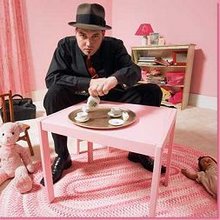Source:
http://www.accessmylibrary.com/coms2/summary_0286-26124547_ITM
This version includes the unedited article but truncated at the end:
BUMPING INTO MR. RAVIOLI. (busyness of life in New York City; effects on a child's imagination)
COPYRIGHT 2002 All rights reserved. Reproduced by permission of The Conde Nast Publications Inc.
My daughter Olivia, who just turned three, has an imaginary friend whose name is Charlie Ravioli. Olivia is growing up in Manhattan, and so Charlie Ravioli has a lot of local traits: he lives in an apartment "on Madison and Lexington," he dines on grilled chicken, fruit, and water, and, having reached the age of seven and a half, he feels, or is thought, "old." But the most peculiarly local thing about Olivia's imaginary playmate is this: he is always too busy to play with her. She holds her toy cell phone up to her ear, and we hear her talk into it: "Ravioli? It's Olivia . . . It's Olivia. Come and play? O.K. Call me. Bye." Then she snaps it shut, and shakes her head. "I always get his machine," she says. Or she will say, "I spoke to Ravioli today." "Did you have fun?" my wife and I ask. "No. He was busy working. On a television" (leaving it up in the air if he repairs electronic devices or has his own talk show).
On a good day, she "bumps into" her invisible friend and they go to a coffee shop. "I bumped into Charlie Ravioli," she announces at dinner (after a day when, of course, she stayed home, played, had a nap, had lunch, paid a visit to the Central Park Zoo, and then had another nap). "We had coffee, but then he had to run." She sighs, sometimes, at her inability to make their schedules mesh, but she accepts it as inevitable, just the way life is. "I bumped into Charlie Ravioli today," she says. "He was working." Then she adds brightly, "But we hopped into a taxi." What happened then? we ask. "We grabbed lunch," she says.
It seemed obvious that Ravioli was a romantic figure of the big exotic life that went on outside her little limited life of parks and playgrounds--drawn, in particular, from a nearly perfect, mynah-bird-like imitation of the words she hears her mother use when she talks about her day with her friends. ("How was your day?" Sighing: "Oh, you know. I tried to make a date with Meg, but I couldn't find her, so I left a message on her machine. Then I bumped into Emily after that meeting I had in SoHo, and we had coffee and then she had to run, but by then Meg had reached me on my cell and we arranged . . .") I was concerned, though, that Charlie Ravioli might also be the sign of some "trauma," some loneliness in Olivia's life reflected in imaginary form. "It seems odd to have an imaginary playmate who's always too busy to play with you," Martha, my wife, said to me. "Shouldn't your imaginary playmate be someone you tell secrets to and, I don't know, sing songs with? It shouldn't be someone who's always hopping into taxis."
We thought, at first, that her older brother Luke might be the original of Charlie Ravioli. (For one thing, he is also seven and a half, though we were fairly sure that this age was merely Olivia's marker for As Old as Man Can Be.) He is too busy to play with her much anymore. He has become a true New York child, with the schedule...
Tuesday, June 26, 2007
Friday, June 22, 2007
Interview with a Witness to a Real Life Mr. Marmalade and Bradley
This NPR interview is a follow up to the story on Charlie Ravioli below:
http://www.npr.org/templates/story/story.php?storyId=3843092
http://www.npr.org/templates/story/story.php?storyId=3843092
Charlie Ravioli: a "Real Life" Mr. Marmalade
This excerpt is from The New Yorker
http://www.newyorker.com/archive/2002/09/30/020930fa_fact_gopnik:
Adam Gopnik, "Bumping Into Mr. Ravioli," The New Yorker, September 30, 2002, p. 80
NEW YORK JOURNAL about the writer’s daughter’s imaginary playmate, Charlie Ravioli...
It seemed obvious that Ravioli was a romantic figure of the big exotic life that went on outside her little limited life of parks and playgrounds-drawn, in particular, from a nearly perfect, mynah-bird-like imitation of the words she hears her mother use when she talks about her day with her friends...
We thought, at first, that her older brother Luke might be the original of Charlie Ravioli. (For one thing, he is also seven and a half, though we were fairly sure that this age was merely Olivia’s marker for As Old as Man Can Be.)...
Charlie Ravioli was becoming so constant and oddly discouraging a companion-"He cancelled lunch. Again," Olivia would say-that we thought we ought to look into it. One of my sisters is a developmental psychologist who specializes in close scientific studies of what goes on inside the heads of one- and two- and three-year-olds...
I also learned that some children, as they get older, turn out to possess what child psychologists call a "paracosm." A paracosm is a society thought up by a child-an invented universe with a distinctive language, geography, and history. (The Brontës invented a couple of paracosms when they were children.) Not all children who have an imaginary friend invent a paracosm, but the two might, I think, be related...
The real question, I saw, was not "Why this friend?" but "Why this fiction?" Why, as Olivia had seen so clearly, are grownups in New York so busy, and so obsessed with the language of busyness that it dominates their conversation? Why are New Yorkers always bumping into Charlie Ravioli and grabbing lunch, instead of sitting down with him and exchanging intimacies, as friends should, as people do in Paris and Rome?...
We build rhetorical baffles around our lives to keep the crowding out, only to find that we have let nobody we love in...
I think we would have learned to live happily with Charlie Ravioli had it not been for the appearance of Laurie. She threw us badly. At dinner, Olivia had been mentioning a new personage almost as often as she mentioned Ravioli. "I talked to Laurie today," she would begin. "She says Ravioli is busy." And then it came to us, with sickening clarity: Laurie was not the patient friend who consoled you for Charlie’s absence. Laurie was the bright-toned person who answered Ravioli’s phone and told you that unfortunately Mr. Ravioli was in a meeting...
Writer tells about listening to Olivia mutter to herself about Ravioli...
(The New Yorker’s archives are not yet fully available online. The full text of all articles published before May, 2006, can be found in “The Complete New Yorker,” which is available for purchase on DVD and hard drive.)
http://www.newyorker.com/archive/2002/09/30/020930fa_fact_gopnik:
Adam Gopnik, "Bumping Into Mr. Ravioli," The New Yorker, September 30, 2002, p. 80
NEW YORK JOURNAL about the writer’s daughter’s imaginary playmate, Charlie Ravioli...
It seemed obvious that Ravioli was a romantic figure of the big exotic life that went on outside her little limited life of parks and playgrounds-drawn, in particular, from a nearly perfect, mynah-bird-like imitation of the words she hears her mother use when she talks about her day with her friends...
We thought, at first, that her older brother Luke might be the original of Charlie Ravioli. (For one thing, he is also seven and a half, though we were fairly sure that this age was merely Olivia’s marker for As Old as Man Can Be.)...
Charlie Ravioli was becoming so constant and oddly discouraging a companion-"He cancelled lunch. Again," Olivia would say-that we thought we ought to look into it. One of my sisters is a developmental psychologist who specializes in close scientific studies of what goes on inside the heads of one- and two- and three-year-olds...
I also learned that some children, as they get older, turn out to possess what child psychologists call a "paracosm." A paracosm is a society thought up by a child-an invented universe with a distinctive language, geography, and history. (The Brontës invented a couple of paracosms when they were children.) Not all children who have an imaginary friend invent a paracosm, but the two might, I think, be related...
The real question, I saw, was not "Why this friend?" but "Why this fiction?" Why, as Olivia had seen so clearly, are grownups in New York so busy, and so obsessed with the language of busyness that it dominates their conversation? Why are New Yorkers always bumping into Charlie Ravioli and grabbing lunch, instead of sitting down with him and exchanging intimacies, as friends should, as people do in Paris and Rome?...
We build rhetorical baffles around our lives to keep the crowding out, only to find that we have let nobody we love in...
I think we would have learned to live happily with Charlie Ravioli had it not been for the appearance of Laurie. She threw us badly. At dinner, Olivia had been mentioning a new personage almost as often as she mentioned Ravioli. "I talked to Laurie today," she would begin. "She says Ravioli is busy." And then it came to us, with sickening clarity: Laurie was not the patient friend who consoled you for Charlie’s absence. Laurie was the bright-toned person who answered Ravioli’s phone and told you that unfortunately Mr. Ravioli was in a meeting...
Writer tells about listening to Olivia mutter to herself about Ravioli...
(The New Yorker’s archives are not yet fully available online. The full text of all articles published before May, 2006, can be found in “The Complete New Yorker,” which is available for purchase on DVD and hard drive.)
N.J. Dialects
Since I grew up in NJ, the setting of the play, one of the cast members asked me about the dialect. NJ accents can vary greatly based on region and socio-economic background. They can range from very subtle to fairly noticeable. I found a resource for people to check out if they're interested. It really depends on the character and his/her age and upbringing as to which dialect might be closest to reality. The female recording is particularly striking in terms of how Emily may sound, for example. http://web.ku.edu/idea/northamerica/usa/newjersey/newjersey.htm
Monday, June 18, 2007
Hara-kiri: more to it than meets the abdomen

Hara-kiri is addressed several times in Mr. Marmalade, including a staged rendition. This photo (staged) shows a Seppuku (Japanese term for hara-kiri, often pronounced hara-hari in the U.S.) in ritual attire, with a second participant preparing to decapitate the victim after the left-to-right (and sometimes upward to end) abdomenal cutting is complete.
"Decapitation?" you ask, "But I thought hara-kiri was a form of suicide." Lose no further sleep over the topic.
This entry from http://www.bartleby.com/65/ha/harakiri.html nicely summarizes the practice:
Hara-kiri [Jap.,=belly-cutting], the traditional Japanese form of honorable suicide, also known by its Chinese equivalent, seppuku. It was practiced by the Japanese feudal warrior class in order to avoid falling into enemy hands. Around 1500, it became a privileged alternative to execution, granted to daimyo and samurai guilty of disloyalty to the emperor. The condemned man received a jeweled dagger from the emperor. He selected as his second a faithful friend, received official witnesses, and plunged the dagger into the left side of his abdomen, drew it across to the right, and made a slight cut upward; his second then beheaded him with one stroke of a sword, and the dagger was returned to the emperor.
And below is more information to help explain the practice and its history (from http://www.answers.com/topic/seppuku-1?cat=entertainment).
Hara-kiri [Jap.,=belly-cutting], the traditional Japanese form of honorable suicide, also known by its Chinese equivalent, seppuku. It was practiced by the Japanese feudal warrior class in order to avoid falling into enemy hands. Around 1500, it became a privileged alternative to execution, granted to daimyo and samurai guilty of disloyalty to the emperor. The condemned man received a jeweled dagger from the emperor. He selected as his second a faithful friend, received official witnesses, and plunged the dagger into the left side of his abdomen, drew it across to the right, and made a slight cut upward; his second then beheaded him with one stroke of a sword, and the dagger was returned to the emperor.
And below is more information to help explain the practice and its history (from http://www.answers.com/topic/seppuku-1?cat=entertainment).
Seppuku is also known as hara-kiri (腹切り, "belly-cutting") and is written with the same kanji as seppuku but in reverse order with an okurigana. In Japanese, hara-kiri is a colloquialism, seppuku being the more formal term. Samurai (and modern adherents of bushido) would use seppuku, whereas ordinary Japanese (who in feudal times as well as today looked askance at the practice) would use hara-kiri. Hara-kiri is the more common term in English, where it is often mistakenly rendered "hari-kari."
OVERVIEW: Seppuku was a key part of bushido, the code of the samurai warriors; it was used by warriors to avoid falling into enemy hands, and to attenuate shame. Samurai could also be ordered by their daimyo (feudal lords) to commit seppuku. Later, disgraced warriors were sometimes allowed to commit seppuku rather than be executed in the normal manner. Since the main point of the act was to restore or protect one's honor as a warrior, those who did not belong to the samurai caste were never ordered or expected to commit seppuku. Samurai women could only commit the act with permission.
In his book The Samurai Way of Death, Samurai: The World of the Warrior (ch.4), Dr. Stephen Turnbull states:

Seppuku was commonly performed using a tanto. It could take place with preparation and ritual in the privacy of one's home, or speedily in a quiet corner of a battlefield while one’s comrades kept the enemy at bay.
In the world of the warrior, seppuku was a deed of bravery that was admirable in a samurai who knew he was defeated, disgraced, or mortally wounded. It meant that he could end his days with his transgressions wiped away and with his reputation not merely intact but actually enhanced.
The cutting of the abdomen released the samurai’s spirit in the most dramatic fashion, but it was an extremely painful and unpleasant way to die, and sometimes the samurai who was performing the act asked a loyal comrade to cut off his head at the moment of agony.
James Clavell, in Shōgun, says that seppuku may have originated, not as a positive good but as the lesser of two evils. The code of bushido, unlike the European codes of chivalry, didn't forbid mistreatment of prisoners or other helpless people. For this reason, a samurai had a reasonable expectation of being tortured after surrendering and would therefore be reluctant to be taken alive. (This would imply that Japanese tortures were unusually frightful, if seppuku was the lesser evil.)
RITUAL: In time, committing seppuku came to involve a detailed ritual. A Samurai was bathed, dressed in white robes, fed his favorite meal, and when he was finished, his instrument was placed on his plate. Dressed ceremonially, with his sword placed in front of him and sometimes seated on special cloths, the warrior would prepare for death by writing a death poem. With his selected attendant (kaishakunin, his second) standing by, he would open his kimono (clothing), take up his wakizashi (short sword) or a tanto (knife) and plunge it into his abdomen, making a left-to-right cut. The kaishakunin would then perform daki-kubi, a cut in which the warrior was all but decapitated (a slight band of flesh is left attaching the head to the body). Because of the precision necessary for such a maneuver, the second was often a skilled swordsman. The principal agreed in advance when the kaishaku made his cut, usually as soon as the dagger was plunged into the abdomen.
This elaborate ritual evolved after seppuku had ceased being mainly a battlefield or wartime practice and become a para judicial institution (see next section).
The second was usually, but not always, a friend. If a defeated warrior had fought honorably and well, an opponent who wanted to salute his bravery would volunteer to act as his second.
In the Hagakure, Yamamoto Tsunetomo wrote:
From ages past it has been considered ill-omened by samurai to be requested as kaishaku. The reason for this is that one gains no fame even if the job is well done. And if by chance one should blunder, it becomes a lifetime disgrace.
In the practice of past times, there were instances when the head flew off. It was said that it was best to cut leaving a little skin remaining so that it did not fly off in the direction of the verifying officials. However, at present it is best to cut clean through.
Some samurai chose to perform a considerably more taxing form of seppuku known as jumonji-giri (十文字切り, lit. "cross-shaped cut"), in which there is no kaishakunin to put a quick end to the samurai's suffering. It involves a second and more painful vertical cut across the belly. A samurai performing jumonji-giri was expected to bear his suffering quietly until perishing from loss of blood, passing away with his hands over his face.
SEPPUKU AS CAPITAL PUNISHMENT: While the voluntary seppuku described above is the best known form and has been widely admired and idealized, in practice the most common form of seppuku was obligatory seppuku, used as a form of capital punishment for disgraced samurai, especially for those who committed a serious offense such as unprovoked murder, robbery, corruption, or treason. The samurai were generally told of their offense in full and given a set time to commit seppuku, usually before sunset on a given day. If the sentenced was uncooperative, it was not unheard of for them to be restrained, or for the actual execution to be carried out by decapitation while retaining only the trappings of seppuku; even the short sword laid out in front of the victim could be replaced with a fan. Unlike voluntary seppuku, seppuku carried out as capital punishment did not necessarily absolve the victim's family of the crime. Depending on the severity of the crime, half or all of the deceased's property could be confiscated, and the family stripped of rank.
SEPPUKU IN MODERN JAPAN: Seppuku as judicial punishment was officially abolished in 1873, shortly after the Meiji Restoration, but voluntary seppuku did not completely die out. Dozens of people are known to have committed seppuku since then, including some military men who committed suicide in 1895 as a protest against the return of a conquered territory to China[citation needed]; by General Nogi and his wife on the death of Emperor Meiji in 1912; and by numerous soldiers and civilians who chose to die rather than surrender at the end of World War II.
CULTURAL IMPACT: Seppuku is occasionally used as a metaphor to imply excessive self-punishment.
Thursday, June 14, 2007
Sounds of Playing
I found a site that offers sound samples of babies crying and children playing. Just put the mouse pointer over the sample icon and it automatically plays. Perhaps it helps enhance the Dodgeball moment's ambiance.
http://www.soundrangers.com/category-results.cfm?storeid=1&cat_id=0112
http://www.soundrangers.com/category-results.cfm?storeid=1&cat_id=0112
Bad Horse Reference

The script's reference to "bad horse" might raise questions for the less street-smart. Contrary to a literal translation of Mr. Ed misbehaving, "bad horse" is a slang term for bad heroin.
Info on the drug from http://www.drugfree.org/Portal/drug_guide/Heroin explains some more about it. Here is an excerpt:
What are the street names/slang terms for
Heroin?
Heroin?
Big H, Blacktar, Brown sugar, Dope, Horse, Junk, Mud, Skag, Smack.
What is Heroin?
Heroin is a highly addictive drug derived from morphine, which is obtained from the opium poppy. It is a "downer" or depressant that affects the brain's pleasure systems and interferes with the brain's ability to perceive pain.
What does it look like?
White to dark brown powder or tar-like substance.
How is it used?
Heroin can be used in a variety of ways, depending on user preference and the purity of the drug. Heroin can be injected into a vein ("mainlining"), injected into a muscle, smoked in a water pipe or standard pipe, mixed in a marijuana joint or regular cigarette, inhaled as smoke through a straw, known as "chasing the dragon," snorted as powder via the nose.
What are its short-term effects?
The short-term effects of heroin abuse appear soon after a single dose and disappear in a few hours.After an injection of heroin, the user reports feeling a surge of euphoria ("rush") accompanied by a warm flushing of the skin, a dry mouth, and heavy extremities. Following this initial euphoria, the user goes "on the nod," an alternately wakeful and drowsy state. Mental functioning becomes clouded due to the depression of the central nervous system. Other effects included slowed and slurred speech, slow gait, constricted pupils, droopy eyelids, impaired night vision, vomiting, constipation.
What are its long-term effects?
Long-term effects of heroin appear after repeated use for some period of time.Chronic users may develop collapsed veins, infection of the heart lining and valves, abscesses, cellulites, and liver disease. Pulmonary complications, including various types of pneumonia, may result from the poor health condition of the abuser, as well as from heroin's depressing effects on respiration.In addition to the effects of the drug itself, street heroin may have additives that do not really dissolve and result in clogging the blood vessels that lead to the lungs, liver, kidneys, or brain. This can cause infection or even death of small patches of cells in vital organs. With regular heroin use, tolerance develops. This means the abuser must use more heroin to achieve the same intensity or effect.
As higher doses are used over time, physical dependence and addiction develop. With physical dependence, the body has adapted to the presence of the drug and withdrawal symptoms may occur if use is reduced or stopped. Withdrawal, which in regular abusers may occur as early as a few hours after the last administration, produces drug craving, restlessness, muscle and bone pain, insomnia, diarrhea and vomiting, cold flashes with goose bumps ("cold turkey"), kicking movements ("kicking the habit"), and other symptoms. Major withdrawal symptoms peak between 48 and 72 hours after the last does and subside after about a week. Sudden withdrawal by heavily dependent users who are in poor health can be fatal.
Wednesday, June 13, 2007
Dodgeball as Hope

Larry inviting Lucy to play Dodgeball provides an interesting insight into Larry's progression and Lucy's future. Dodgeball is for a group of players, which means it would require more than just Lucy and Larry. Has Larry made neighborhood friends following the birth of his clear desire to live? It's so touching when Bradley encourages her. The make-believe element gives permission for reality to gain momentum, possibly eliminating the make-believe and replacing it with a real future and hope for connection. Imagine the sounds of kids shouting and playing as the REAL games begin.
Playing Doctor


There are a few references to "playing doctor" in the script and one scene plays out the event, but what are the implications of the game? What is its significance in the play?
From http://www.drspock.com/:
Ask Dr. Needlman
Playing Doctor
QUESTION
Our neighbor boy is 5 years old, and every time he plays with our 5-year-old son, he asks our son to pull his pants down. We have talked to his parents (they are good friends of ours), and they have talked to their son, but he keeps doing it. We have told our son to come tell us when it happens, and he has done so. We already have made a rule that they are not allowed to play unsupervised. Should we be concerned about this type of behavior? Is it normal? (By the way, the little boy admits to his behavior and seems to know it's wrong and feels ashamed.)
— Concerned Mom
ANSWER
I think that it's normal for boys and girls who are 4, 5, and 6 years old to be very interested in their bodies, particularly their private parts. They are aware of the differences between boys and girls and men and women, and are very involved in figuring out their own sexual identities. Some amount of exploration with other children of either sex (often called "playing doctor") is really expected and normal.It's also reasonable for parents to put limits on this behavior. They can explain to their young children that certain parts of the body are private, and that means you don't show them to other people except under certain circumstances (e.g., in the doctor's office). They don't have to explain why, just mention it matter-of-factly as one of those rules that exists for polite, proper behavior.
From the standpoint of your own son, I think you are handling the situation well. You've set a reasonable limit for his behavior, and you are enforcing it. The more matter-of-fact you can be, the more comfortable your son will feel that he has not done anything wrong. Children do best when they can understand the rules about privacy without feeling that their bodies are something to be ashamed of.
Your son's friend has been told that his behavior is inappropriate, and yet he persists in his exploring game. When he's confronted, he feels bad and promises to stop. But the next time the opportunity to satisfy his sexual curiosity arises, the temptation is too great. This persistent interest may be completely normal, or it might reflect an uncomfortable preoccupation with sex.
Young children who have been exposed to sexual material of an adult nature sometimes have a lot of anxious feelings about sex. They may focus on genital exploration to the exclusion of other activities, or feel compelled to compare their own genitals to other children's to make sure they're okay. Of course, I don't know if any of these factors apply to your son's friend, but if his parents are concerned, they should seek consultation with a physician or a psychologist. Timely intervention by a trained therapist can be very helpful for children who have a great deal of anxious feelings about their sexuality.
Finally, a word about sexual abuse. Nothing in your case really suggests this, but it's something that parents often worry about. Children who have been sexually abused sometimes feel compelled to re-enact adult sexual acts. Usually this is not just a matter of playing doctor.
— by Robert Needlman, M.D., F.A.A.P.
From http://www.drspock.com/:
Ask Dr. Needlman
Playing Doctor
QUESTION
Our neighbor boy is 5 years old, and every time he plays with our 5-year-old son, he asks our son to pull his pants down. We have talked to his parents (they are good friends of ours), and they have talked to their son, but he keeps doing it. We have told our son to come tell us when it happens, and he has done so. We already have made a rule that they are not allowed to play unsupervised. Should we be concerned about this type of behavior? Is it normal? (By the way, the little boy admits to his behavior and seems to know it's wrong and feels ashamed.)
— Concerned Mom
ANSWER
I think that it's normal for boys and girls who are 4, 5, and 6 years old to be very interested in their bodies, particularly their private parts. They are aware of the differences between boys and girls and men and women, and are very involved in figuring out their own sexual identities. Some amount of exploration with other children of either sex (often called "playing doctor") is really expected and normal.It's also reasonable for parents to put limits on this behavior. They can explain to their young children that certain parts of the body are private, and that means you don't show them to other people except under certain circumstances (e.g., in the doctor's office). They don't have to explain why, just mention it matter-of-factly as one of those rules that exists for polite, proper behavior.
From the standpoint of your own son, I think you are handling the situation well. You've set a reasonable limit for his behavior, and you are enforcing it. The more matter-of-fact you can be, the more comfortable your son will feel that he has not done anything wrong. Children do best when they can understand the rules about privacy without feeling that their bodies are something to be ashamed of.
Your son's friend has been told that his behavior is inappropriate, and yet he persists in his exploring game. When he's confronted, he feels bad and promises to stop. But the next time the opportunity to satisfy his sexual curiosity arises, the temptation is too great. This persistent interest may be completely normal, or it might reflect an uncomfortable preoccupation with sex.
Young children who have been exposed to sexual material of an adult nature sometimes have a lot of anxious feelings about sex. They may focus on genital exploration to the exclusion of other activities, or feel compelled to compare their own genitals to other children's to make sure they're okay. Of course, I don't know if any of these factors apply to your son's friend, but if his parents are concerned, they should seek consultation with a physician or a psychologist. Timely intervention by a trained therapist can be very helpful for children who have a great deal of anxious feelings about their sexuality.
Finally, a word about sexual abuse. Nothing in your case really suggests this, but it's something that parents often worry about. Children who have been sexually abused sometimes feel compelled to re-enact adult sexual acts. Usually this is not just a matter of playing doctor.
— by Robert Needlman, M.D., F.A.A.P.
Thursday, June 7, 2007
Video of Hara Kari Reenactment
This could help Mr. Marmalade and Larry understand what Hara Kari looks like in action. Note: No actors were hurt in the making of this video (I presume):
http://www.youtube.com/watch?v=N6RB62gHO6U
http://www.youtube.com/watch?v=N6RB62gHO6U
Subscribe to:
Posts (Atom)






